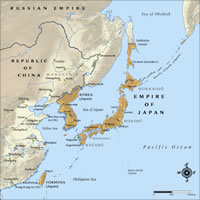Flag

1914 Map
Click on map for more detail
General facts
- Population: 52 million (1914)
- Capital: Tokyo (1920 population 3.7 million)
Government
- Head of State: The Taishō Emperor (Yoshihito) (30 July 1912 – 25 December 1926)
- Head of Government:
- Prime Minister Ōkuma Shigenobu (16 April 1914 – 9 October 1916)
- Prime Minister Count Terauchi Masatake (9 October 1916 – 29 September 1918)
- Prime Minister Hara Takashi (29 September 1918 – 4 November 1921)
Participation in the War
- Entered the war: 23 August 1914 (Japan declared war on Germany)
- Ceased hostilities: 11 November 1918 (armistice with Germany)
- Ended belligerent status: 10 August 1920 (Treaty of Sèvres signed with Ottoman Empire)
Military Force
Army
- Peacetime strength 1914: 380,000
- Reserves 1914: 470,000 (including Second Line Reserves, Conscript Reserves and National Militia)
- Total mobilised 1914: 380,000
- Total mobilised during war: 800,000
- The overall total includes expeditionary forces that were sent to occupy the German colonial territory of Qingdao on the Shandong Peninsula in China in 1914 and to Siberia in 1918 to intervene in the Russian Civil War on the side of Russian anti-Bolshevik forces.
The German port and naval base at Qingdao, in Shandong province in northern China, was the peacetime headquarters of the German Navy’s powerful East Asia Squadron of half a dozen modern battlecruisers and cruisers. These warships left port at the outbreak of the war to raid Allied shipping in the Pacific and Indian oceans. In early September 1914 the Japanese landed 29,000 troops on the coast of Shandong and, supported by a small British force, placed the German base under siege. After two months of fighting the German garrison surrendered on 7 November. The Japanese extended their occupation to the rest of Shandong Province in 1915, despite protests from China. Japanese troops also occupied the German colonial territories of the central Pacific – the Mariana, Caroline and Marshall Islands – without any resistance. This was the outer limit of Imperial Japanese Army operations during the First World War.
Navy
- Peacetime strength 1914: 48,000
- Reserves 1914: 15,000
Fleet (1914)
- Battleships (Dreadnoughts): 2
- Battleships (pre-Dreadnoughts): 16
- Battlecruisers: 6
- Cruisers: 9
- Light cruisers: 15
- Destroyers: 54
- Submarines: 18
The Imperial Japanese Navy (IJN) blockaded Qingdao and supported Japanese ground forces in their siege of the German naval base in late 1914. The IJN played an active role in the Allied war effort until the end of the war. Its naval operations were initially concentrated on helping the French and British navies hunt down and eliminate the powerful modern warships of the German Far East Squadron in the Pacific and Indian oceans. Once this was accomplished the IJN established regular patrols through these oceans to guard against any future German naval activity in the area. Japanese destroyers and cruisers were based at the British port of Singapore for the duration of the war as part of this work.
The Japanese cruiser HIJMS Ibuki helped escort the first convoy carrying New Zealand and Australian troops to Egypt in October 1914. The Japanese Navy returned to Australian and New Zealand waters in strength in March 1917, when a squadron of Japanese warships was sent to the region in response to the exploits of German auxiliary cruisers such as the Wolf. The Japanese ships patrolled off the east coast of Australia and around New Zealand for the rest of 1917. At the request of the British, in April 1917 the Japanese also sent a squadron of destroyers to serve as troop convoy escorts in the Mediterranean.
The IJN lost two ships – the cruiser HIJMS Takachiho was sunk by the German destroyer S-90 in operations around Qingdao in 1914 and the destroyer HIJMS Sakaki was torpedoed in the Mediterranean in 1917.
Casualties
Military
- Dead (all causes): 2000
- Wounded: 5100
The majority of these casualties were suffered by Imperial Japanese forces involved in the siege of Qingdao. They do not include casualties suffered by the expeditionary force sent to Siberia in 1918.
Sources
- Frederick Dickinson, War and National Reinvention: Japan in the Great War, 1914–1919, Harvard University Press, Cambridge MA, 1999
- Spencer C. Tucker (ed.), The Encyclopedia of World War I: Volume 2, ABC-CLIO, Santa Barbara CA, 2005

